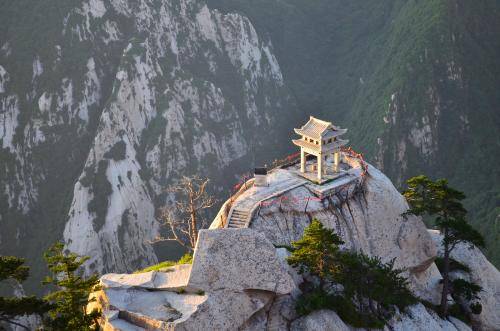Mount Hua
Anciently known as 'Western Great Mountain', it is one of the famous Five Great Mountains of China, located in Huayin City, Shaanxi Province. Known as 'Taihua Mountain', Mount Hua is the birthplace of Chinese civilization. The 'Hua' in 'China' and 'Huaxia' originates from Mount Hua.
Shaohua Mountain Forest Park
Shaohua Mountain Scenic Area is located in the southeast of Huaxian County, Weinan City, about 7 kilometers from the county seat, and is named after Shaohua Mountain. The scenic area includes five sub-scenic areas: Shaohua Peak, Qianlong Temple, Hongya Lake, Shimen Gorge, and Dense Forest Valley. Historically, Shaohua Mountain is known for its steepness and is often mentioned alongside Mount Hua as the 'Two Huashan'. The famous novel 'Water Margin' features many historical stories about the Nine-Patterned Dragon in this area. During the late Sui Dynasty, the Green Forest hero Wang Botang also gathered here, and the stone fort from that time still exists today. Nowadays, Shaohua Mountain is more of a place for hiking, fitness, and getting close to nature. The mountain within Shaohua Mountain is steep, with majestic peaks, magical boulders, gorges, and waterfalls. The dense forest makes the air exceptionally fresh, and even in the hottest summer, it is cool on the mountain, making it a great place for a summer vacation.
Located 9 kilometers northeast of Hancheng city and only 3 kilometers from the Yellow River, Dangjia Village is the best-preserved Ming and Qing dynasty village in China, known as the 'living fossil of ancient oriental villages.' Dangjia Village has a history of over 660 years. In the second year of Zhishun in the Yuan Dynasty (1331), Dang Shuxuan settled here and lived by farming. During the Yongle period of the Ming Dynasty, his grandson Dang Zhen passed the imperial examination and planned the construction of the village. In the Chenghua period of the Ming Dynasty, the Dang and Jia families intermarried and jointly established the 'Hexingfa' business, trading in the Zhumadian area of Henan, with prosperous business extending to Hankou and Foshan. According to family records, the village at that time 'earned a thousand taels of silver daily,' making it the wealthiest in Hanyuan. In the eighth year of the Ming Dynasty, Dang's nephew Jia Zhang moved to Dangjia Village, and the two families intermarried. With abundant financial resources, the construction of siheyuan (courtyard houses) reached its peak in the late Ming and early Qing dynasties. In the Xianfeng period of the Qing Dynasty (1851), to defend against bandits, they raised 18,000 taels of silver to build Biyang Fort, merging the village and the fort into one.
Dali Shanyuan Tongzhou Desert
Located in Shanyuan Village, Qiangbai Town, Dali County, the 'Tongzhou Desert' boasts over a thousand acres of desert dunes. Visitors can experience the charm of the desert without leaving Shaanxi. A large desert playground covering thousands of acres has been built, featuring over 20 camel teams and more than 50 beach ATVs. Visitors can fully enjoy activities such as sand sliding, desert go-karting, sand surfing, rock climbing, and camel riding to get a feel of the desert. When tired from running and playing, visitors can sit in the 'sand nest' and taste the special snacks of Dali, refreshing the entire desert experience.
Climbing the North Peak of Mount Hua, then turning south, passing through the Ear-Scraping Cliff and the Heavenly Ladder, you will see a long ridge. The ridge is black, piercing the sky, resembling a soaring dragon, hence the name 'Canglong Ridge'. The steps on this ridge are only about two feet wide, with deep ravines on both sides, steep as if cut by knives and axes. The height difference between the top and bottom of the ridge is about 500 meters, with a slope greater than 45 degrees. From a distance, you can see green pines and white clouds, and hear the sound of the wind, which is quite thrilling.













